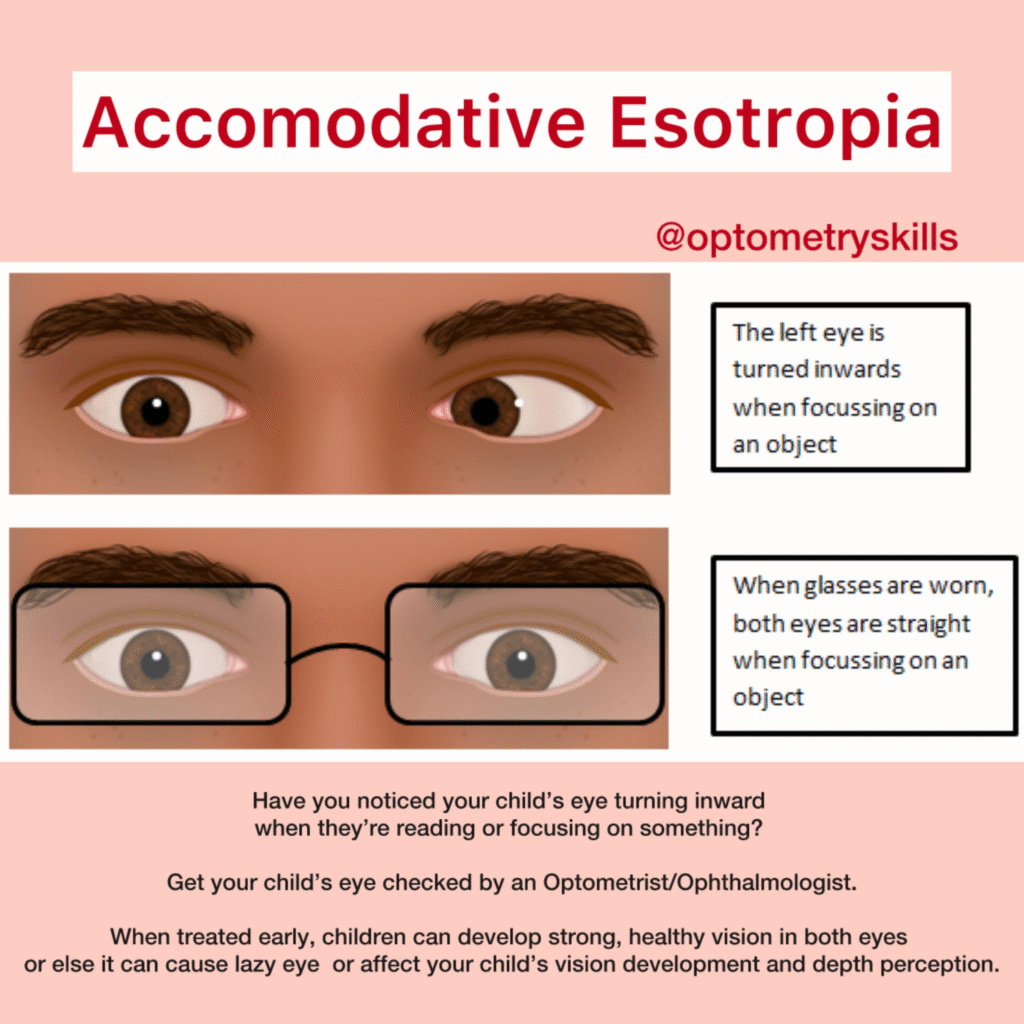
Accommodative Esotropia Awareness: Understanding a Common Childhood Eye Condition
What Is Accommodative Esotropia?
Accommodative esotropia is a type of strabismus (eye misalignment) that usually develops in early childhood. In this condition, one or both eyes turn inward, especially when the child is focusing on a near object. This inward turning is triggered by the eyes’ effort to focus (accommodate) due to uncorrected farsightedness (hyperopia).
This condition is common in children between the ages of 6 months and 7 years and can affect depth perception and visual development if not treated early.

Why Awareness Matters
Accommodative esotropia often develops gradually and may be mistaken for occasional eye crossing. However, if left untreated, it can lead to permanent vision problems, such as:
- Amblyopia (lazy eye)
- Loss of binocular vision
- Poor depth perception
Raising awareness helps parents, caregivers, and educators recognize the early signs and seek timely eye care, ensuring the child’s vision develops normally.
What Causes Accommodative Esotropia?
The condition occurs when a child with uncorrected hyperopia tries to focus on objects, particularly at near distances. To focus clearly, the eyes must accommodate (increase lens power) and converge (turn inward). In some children, this convergence response is excessive, causing the eye(s) to turn inward even when it’s not necessary.
Risk factors include:
- Moderate to high farsightedness
- A family history of strabismus
- Delayed visual development
Common Signs and Symptoms
Parents or teachers may notice:
- One eye turning inward, especially when the child is tired or looking at close objects
- The child closing or covering one eye while focusing
- Squinting, tilting the head, or rubbing the eyes
- Complaints of double vision
- Difficulty with reading or near tasks
- Eye misalignment that becomes more frequent over time
How Is It Diagnosed?
Diagnosis involves a comprehensive pediatric eye exam performed by an optometrist or ophthalmologist. Key elements include:
- Visual acuity testing
- Refraction (to measure the child’s eyeglass prescription)
- Ocular alignment tests
- Evaluation for amblyopia
In many cases, cycloplegic drops are used during the exam to relax the eye’s focusing muscles and get an accurate measurement of refractive error.
Treatment Options
The main goal of treatment is to align the eyes and support proper visual development. Treatment options may include:
1. Eyeglasses
- Children with accommodative esotropia often require full-time wear of glasses that correct hyperopia.
- Once the correct prescription is in place, the eyes are usually able to stay straight during both near and distance activities.
2. Bifocals
- Some children, especially those with persistent crossing at near, may need bifocal lenses to reduce the focusing effort at close distances.
3. Patching or Vision Therapy
- If amblyopia is present, patching the stronger eye helps improve vision in the weaker one.
- In some cases, vision therapy may be recommended to support binocular vision development.
4. Surgery
- If the eyes remain misaligned despite glasses, or if the esotropia becomes partially or non-accommodative, strabismus surgery may be needed to realign the eye muscles.
Long-Term Outlook
With early diagnosis and consistent treatment, the outlook for children with accommodative esotropia is excellent. Most children are able to achieve good alignment, develop binocular vision, and maintain strong vision in both eyes.
However, regular follow-ups are essential, as the condition and the prescription may change with growth. In some cases, the need for glasses may reduce over time, while others may require correction into adolescence or adulthood.
Supporting Parents and Caregivers
It’s important to educate parents and caregivers that:
- Early signs of eye crossing should never be ignored, especially if persistent beyond 4 months of age.
- Children should have their first comprehensive eye exam by age 1, or earlier if any signs are present.
- Wearing glasses consistently as prescribed is crucial for long-term success.
- Children may not complain about vision problems, so observation plays a key role.
Final Thoughts
Accommodative esotropia is one of the most common and treatable forms of childhood eye misalignment. With early recognition, proper correction, and regular monitoring, children with this condition can enjoy normal visual development and a lifetime of healthy vision.
Raising awareness among parents, teachers, and healthcare providers can make all the difference in early detection and timely care. Let’s work together to ensure every child has the clear, comfortable vision they deserve.
Follow this in Facebook
https://www.facebook.com/photo?fbid=1129538655859310&set=a.459672666179249
See other Eye Care posters
